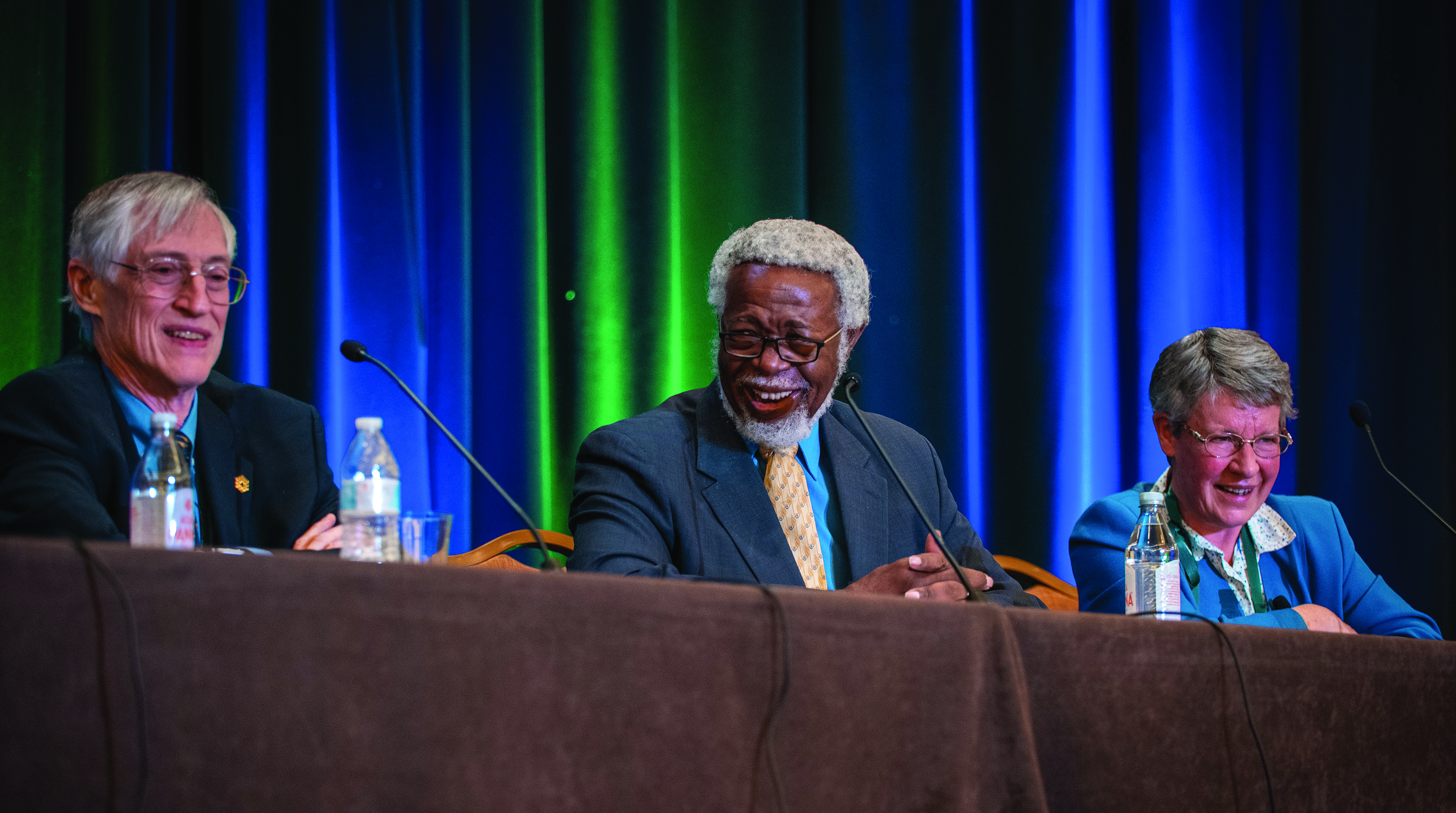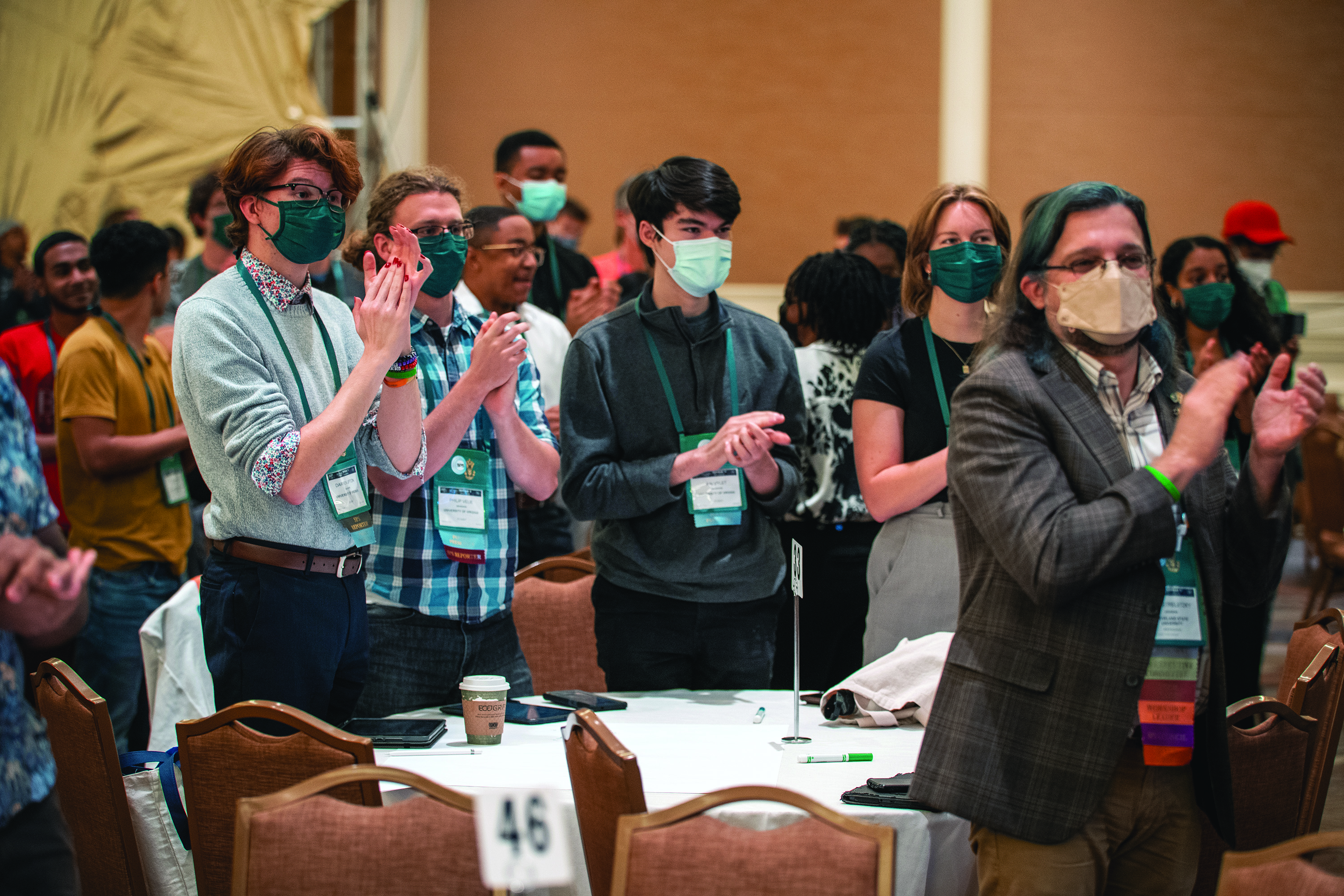Where Will Physics and Astronomy be in 100 Years?
Spring
2023
Feature
Where Will Physics and Astronomy be in 100 Years?
The 2022 Physics Congress Centennial Plenary
By:Joe Hall, Philip Laduca, Nasir Perera-Olivio, Smita Rajan, and Ekin Secilmiis, SPS Reporters, Brown University
The ballroom is humming with the activity of over a thousand physics students, professors, and professional scientists. We’re in the same room for the first time since the 2019 Physics Congress, and the sense of awe and gratitude is palpable. But the room is filled with even more excitement than you might expect because of what’s coming next. You don’t get to see something like this every year, maybe every 100 years.
In a special centennial plenary to celebrate the 100th birthday of Sigma Pi Sigma, the physics and astronomy honor society, the Physics Congress hosted four of the most distinguished faces in physics and astronomy today, all on stage at the same time. They span a variety of disciplines, backgrounds, and perspectives. The room fell silent as SPS director Brad Conrad and members of the SPS Council introduced the panel members.
First up was honorary chair Dame Jocelyn Bell Burnell, an accomplished astrophysicist and advocate perhaps best known for discovering radio pulsars as a graduate student. Next was Dr. S. James (Jim) Gates, Jr., a renowned theoretical physicist and former science and technology advisor to President Barack Obama. Then came Dr. John Mather, Physics Nobel laureate and senior project scientist on the James Webb Space Telescope (JWST). Completing the panel was Dr. Eric Cornell, an AMO (atomic, molecular, and optical) physicist who won a Physics Nobel Prize for synthesizing the first Bose-Einstein condensate.
Each speaker had 10 minutes to answer the same question: Where will physics and astronomy be in 100 years?
Speaking first as honorary chair, Dame Burnell discussed the past and future of astrophysics. She talked about being the only woman in her physics classes at the University of Glasgow and how the isolation and discrimination motivated her to create more opportunities in science for young women. She proudly noted that in 2019, the cutting-edge Vera C. Rubin Observatory in Chile became the first major telescope named after a woman (in 2020, NASA’s Nancy Grace Roman Space Telescope became the second). Dame Burnell concluded by discussing promising directions for astrophysics, notably particle astrophysics, neutrino physics, dark matter, and dark energy.
Dr. Gates began much differently—by showing the crowd a photo of himself at age five. He discussed his love of science fiction as a child, saying that even then, he considered science a “way to have fun.” Dr. Gates also spoke about the need for greater diversity in physics. He expressed his hope that physics will not only consist of a more diverse group of people in 100 years but will also have more diversity of thought and creative problem-solving. He cited the rise of computer science and computational physics as examples of new techniques becoming available to physicists. Finally, Dr. Gates highlighted the importance of communicating and engaging with the public as scientists, drawing on his experience at the White House.
Dr. Mather began by sharing his fascination with the origin of life. He mentioned early in his talk that space exploration and astrobiology will be valuable facets of physics and astronomy in the future, and he encouraged everyone in the audience to “build something nobody’s ever built before.” As the senior scientist on the JWST, he talked about how the success of future experiments will depend on large-scale collaborations across countries and fields of study. Dr. Mather pointed to quantum optics and information as new frontiers, and he reiterated the exciting opportunities ahead in the search for life outside of Earth.
Dr. Cornell looked to physics’ past to predict its future. At the beginning of the talk, he confidently stated that in 100 years, physics will be “very, very different, but pretty much the same.” What does this mean? He explained that the core principle of physics, which distinguishes it from other sciences, is that it can “explain a lot with a little.” He argued that broad principles such as relativity, conservation, and symmetry are fundamental to physics. He noted that some of the biggest research subjects of the last 100 years, including supersymmetry, semiconductors, and quantum mechanics, had their heyday, but interest gradually waned as scientists answered many of the major questions in those areas. He reminded the audience that a desire to explain the world is all you need to be a physicist, and the crowd cheered back at him when asked to repeat the words, “I AM AN AWESOME PHYSICIST!”
After the last speaker, the room erupted with questions. Hundreds of hands raised, their owners hoping for answers and the opportunity to talk to their heroes. During the Q&A, the speakers shared refreshing, unique predictions for the future, but several key themes emerged. All the panelists underlined the importance of having diverse people and diverse thought in physics and astronomy. While acknowledging that the fields are becoming more inclusive, “We’re still not there yet,” according to Dame Burnell. The panelists also agreed that communicating science to the public is vital. Doing so supports a healthy community and opens physics and astronomy to new perspectives. Additionally, Dr. Cornell noted the rise of many interdisciplinary fields, such as climate physics, while Dr. Mather pointed to the fundamental value of collaboration across institutions and borders. Together, these four leaders envision a time when physics and astronomy will be inclusive, outward reaching, and interdisciplinary, no matter what amazing scientific discoveries the future holds.



